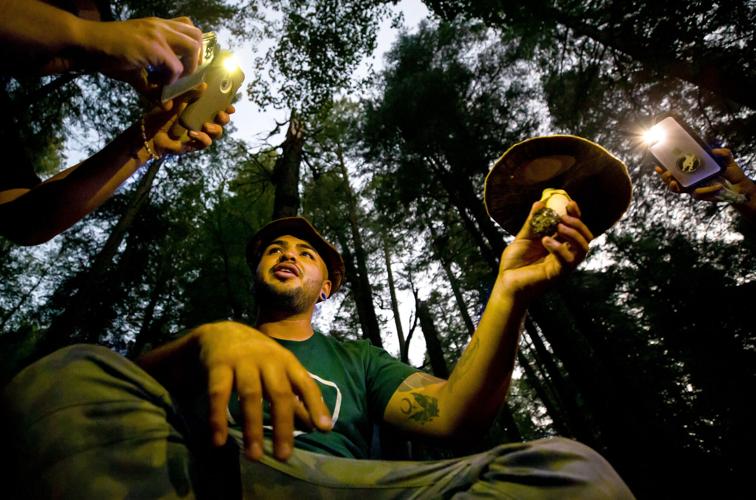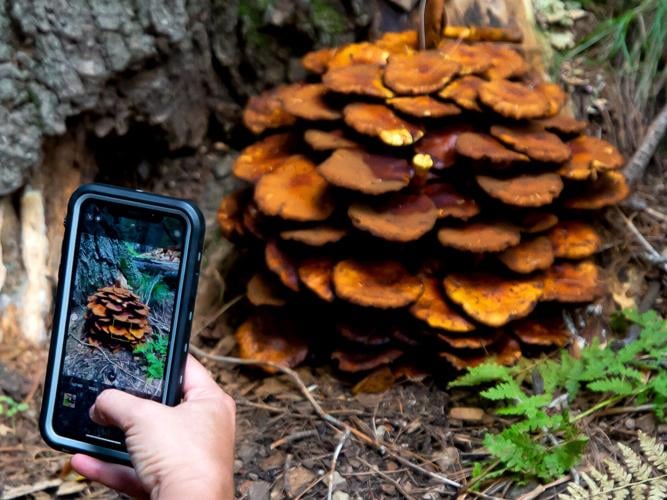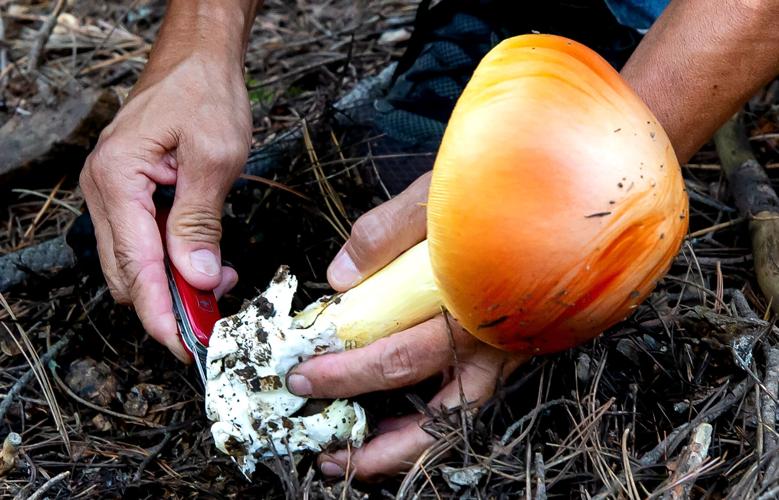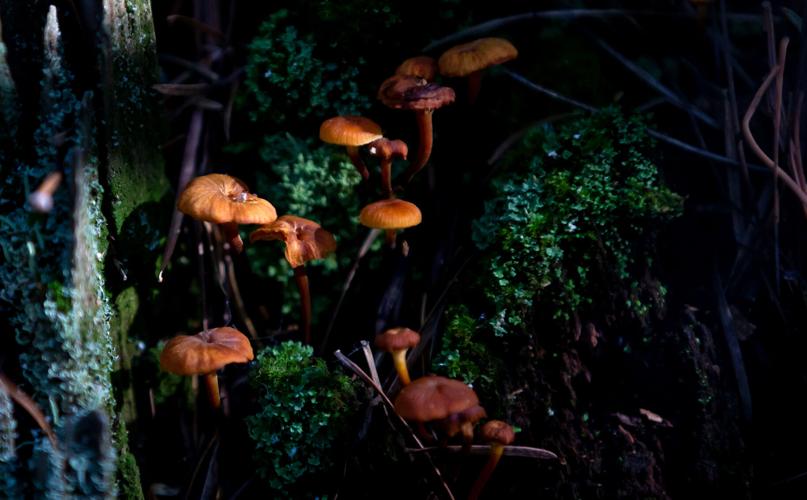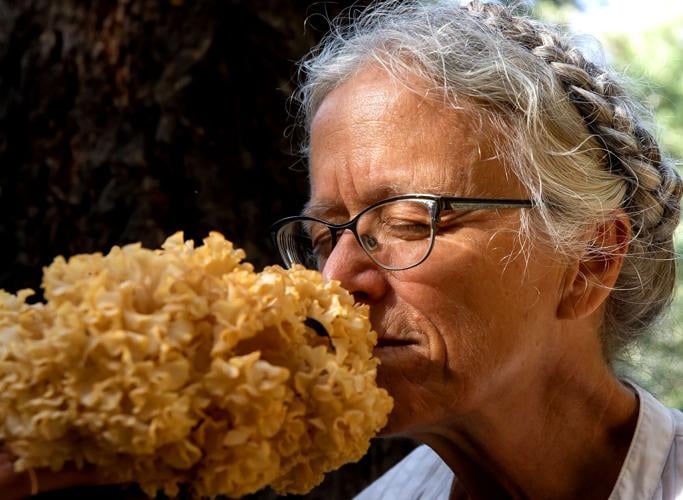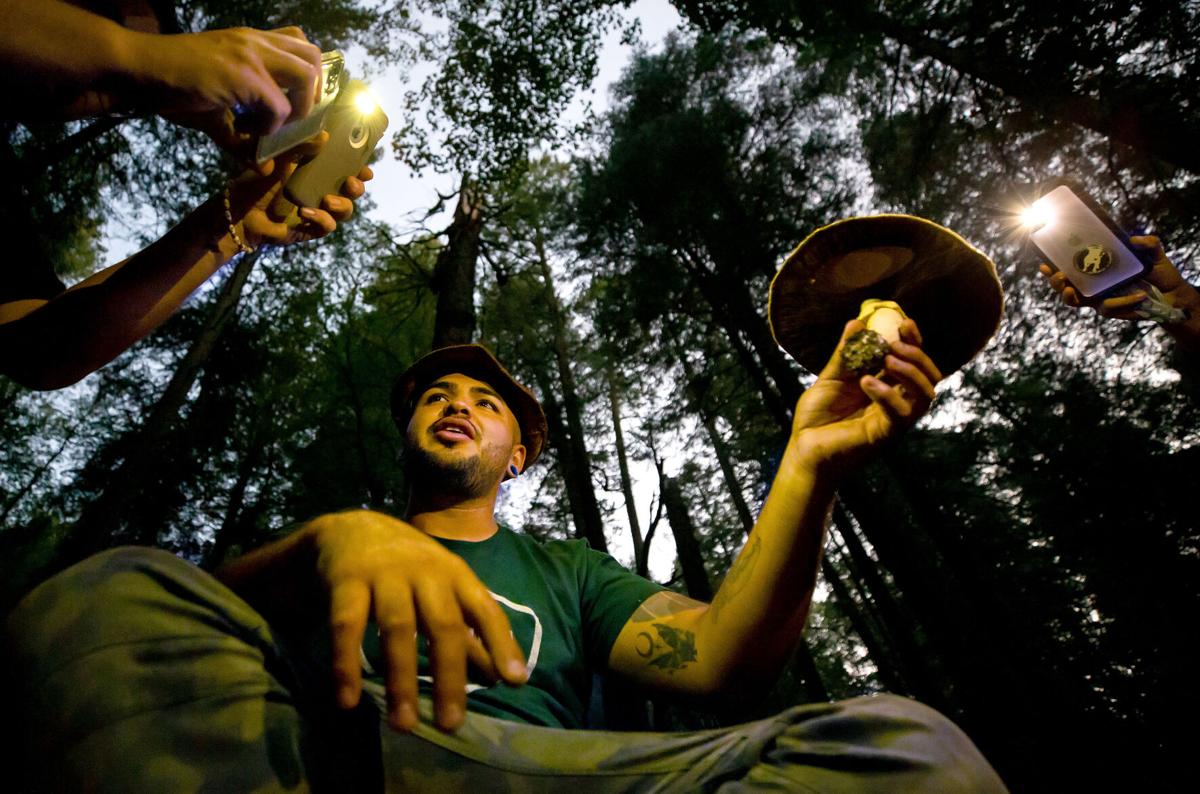Editor's note: This story was originally published on Sept. 4, 2021. We've republished it in 2023 because the 2023 foraging season has started.
Thin sheets of rain break through the canopy of trees at Bear Wallow on Mount Lemmon. The clouds emerged out of nowhere, unforecasted, so the sun has been reluctant to leave. Droplets carry the fading sunshine into what feels like a subterranean world. Our group walks through rays of water, a gently dispersed Jacob’s ladder.
Hernan Castro is in charge of the foray. He studies fungi and has been foraging in these mountains for nearly a decade, leading us with a preternaturally gentle voice, as if everywhere could be some kind of sacred library. Perhaps he sees it that way: someone attuned to the world of fungi is constantly aware of the potential for feasting, healing and death hidden in ordinary scenes.
“Mushrooms don’t tend to grow on paths, and if they did, someone probably would have taken them already,” Castro said.
Over the course of the next seven hours, he shares many places mushrooms like to grow. Oyster mushrooms feed on dying trees that are still upright. A mushroom that sweats droplets full of antiviral properties grows on rotting logs. White king boletes (aka the choice edible porcini) sprout up along the root paths of healthy maple trees. Deadly amanitas, whose amatoxin disentangles your DNA and shuts down vital organs over the course of weeks, hatch out of sinister eggs called vulva.
Castro carries a woven basket full of an array of these mushrooms. They all grow on the Sky Island of Mount Lemmon, one of the most diverse mushroom habitats in the United States.
“I grew up wanting to get out of Tucson and go to a bigger city,” Castro said. “Only now I can see that I was supposed to be here all along.”
The Sky Islands of northern Mexico and the southwestern U.S. are environmental anomalies, places where alpine meadows and desert plains coexist within the same square miles, separated by altitude, rather than longitude.
You’ve experienced this if you’ve ever driven up Mount Lemmon, with its five ecological zones: first the shrubs of the Sonoran flatlands are supplanted by saguaros, then oak trees, then ponderosa pine, before reaching the same fir trees that abound in Canada. Each of these ecological zones allows for a different crop of fungi, which feed on the decomposing plants unique to each area. Sky Islands’ diversity of mushrooms is unparalleled.
The best window to forage in Tucson is our brief, late summer. Mushrooms are the fruiting bodies of fungus, connected by tangled mats of mycelium (sometimes only one cell thick) that act as their lungs, stomach and eyes. When the monsoon rains come down, the fungus flowers and creates a bounty.

Janet Miller, volunteer mushroom forger, smells a cauliflower mushroom.
Last week, Hernan had found a cauliflower mushroom on the high slope of the wallow. Forget the toadstool. The cauliflower mushroom looks like a pale flesh-colored cluster of geraniums. “This is my favorite mushroom ever,” Castro said. “They taste the best.” A young specimen, he said, smells like the chicken flavor packet of Top Ramen.
He leads a troupe of amateur mushroom enthusiasts down a slope, to the base of a tree. We follow, meandering through a spongy layer of damp undergrowth, searching with unfocused eyes to spot a telltale, irregular-yet-organic, shape on the horizon.
“This is my hiding spot,” he said, when we had gathered in a loose circle around him. “Well, one of them,” he said in a tone both sheepish and suggestive.
He crouched down and felt around for a loose piece of moss-covered bark, just slightly out of place. In an act of theater, he pulled back the partial log to reveal a cauliflower mushroom the size of a child’s head. Everyone gasped in unison, as if on cue.
It’s beautiful and strange. The elaborate shape and bloodless color are completely foreign in this land of muted greens and browns. The moment Castro revealed it to us was a manufactured discovery, but still full of awe. Many of the people who had signed up for the foray were repeat customers: the $30 service fee pays for itself with the gourmet mushrooms they take home, let alone the sense of wonder.
“If I could make a living just leading forays, I would,” said Castro. “Unfortunately, there’s such a brief season, I need to be able to make ends meet the rest of the year.”
The man behind the mushrooms
Off season, from early October though early July, Castro is foremost the proprietor of a mercantile called The Desert Alchemist. He sells extracts of mushrooms well-known for their medicinal properties alongside Chaga coffee and paraphernalia (not that kind): shirts that say “Die Once Live Forever,” keychains of mushrooms in papier-mache.
Castro is always looking to collaborate. “I have a running lecture series at a beauty school,” he said. “We’re thinking about making a line of products pigmented with mushrooms, but mostly they enjoy learning about mushrooms in general. I give a speech, a little like a TED Talk, about the basics of mycology. It’s always a hit.”
He recently secured a collaboration he had been pitching for years: mushroom-infused beer. He uses the facility at Catalina Brewing Company to create and store his extracts and is friends with the owners. Although they had been long skeptical about the product, when he finally convinced them to produce a batch of lion’s mane-infused beer — the Ponderosa Pioneer — at the beginning of August, the beer sold out within 24 hours. They’re already working on the next installment.
When we interviewed at Savaya Coffee, he made sure to ask the barista to get in touch with the owners. Mushroom coffee, blended with medicinal mushrooms like chaga and lion’s mane, is a popular trend he could help them capitalize on.

Justine Hernandez takes a picture of a cluster of Sulfur Tuft mushrooms at Bear Wallow in the Santa Catalina Mountains outside Tucson, Ariz.
Mushrooms as medicine
Castro casts himself in the model of Paul Stamets, a self-taught mycologist who is an “intellectual and industry leader in fungi” and featured in the 2019 Netflix documentary “Fantastic Fungi” (which everyone in our foray cohort insisted I watch). While studies of the medicinal value of mushrooms suffer from a lack of institutional or pharmaceutical research funding in the U.S., Stamets is an exception, working with the National Institutes of Health and Virology to test antiviral properties of fungi.
Castro believes in the medicinal value of mushrooms because he has witnessed them firsthand. He was introduced to the world of mycology after his father suffered multiple strokes within a few months. Half of his body was paralyzed, and some brain functions seemed to be gone forever. Doctors told Castro that healing the brain damage was impossible.
“They were telling me that he only had so long left to live, and that I needed to focus on maintaining his quality of life,” Castro said. “I just couldn’t take that as my only answer.”
So he started researching in earnest, reading any peer-reviewed paper he could get his hands on that reported the chance of regrowing brain tissue. He came across one from Japan that studied the ability of a compound found in lion’s mane mushrooms to heal oxygen-deprived, dead brain cells.
“I ordered lion’s mane cultures online and started growing my own to distill into medicine. I told my dad, this might not do anything, but it isn’t going to hurt you. To give it the chance to work, though, you have to take it three times a day, every day. And he did like I told him to, religiously.
“In six months, he had regained use of his full body. When the doctors scanned his brain, they said the dead tissue had regrown,” Castro said.
Castro knows this is anecdotal evidence. “You’re not allowed to officially say mushrooms have any of these medicinal properties because the FDA hasn’t tested them yet,” he said. “I want them to do those studies.” Castro is under the impression that the pharmaceutical companies wouldn’t be willing to approve something that could heal people and be grown cheaply at home.
For now, mushrooms remain understudied. “Taking mushrooms” still connotes tripping on psilocybin. The realm of mycology is mysterious to most consumers. Mushrooms make the most sense to me bundled into a blue styrofoam basket wrapped in plastic wrap, that I can buy for $3.90 off the misted shelves of Safeway.
“The species of mushroom they grow industrially, classic white or brown mushrooms, actually contain a highly unstable compound,” Castro said as we meandered down the side of Mount Lemmon. “It decomposes when cooked, but in high amounts, it can act as a carcinogen.”

Cynthia Lee, volunteer mushroom forger, gathers a Caesar Amanita mushroom at Bear Wallow.
Embarking on a treasure hunt
We had been biding our time in Bear Wallow, waiting out a huge burst of rain that drenched the narrow ravine near ski valley that was rumored to have chanterelles.
“I mean, chanterelles!” a forager emphasized, her eyes expanding to make the point. The apricot-colored and -scented delicacy resists commercial cultivation and can cost hundreds of dollars for mere pounds.
When we finally made it to the ravine, we were racing against the falling darkness. Twilight filtered through the canopy took on the quality of moonlight, illuminating the oyster mushrooms that studded trees from within. The group took turns poking the white clusters down with long sticks.
“That’s enough on this one,” Castro said, and the group moved on. Without regulation, Castro fears that foraging could suffer the tragedy of the commons. Mushrooms play a crucial role as decomposers in the ecosystem, and overharvesting could lead to serious environmental impact.
“I make sure that people on my forays are only taking a gallon-sized basket, a few times each season,” said Castro. “Unfortunately, I can’t say that for everyone who forages here.” He’s been trying to work with the Forest Service to create a formal system with clear rules, but it’s a slow process.
The troupe out today was especially discerning. The lure of the chanterelles kept their baskets light in the first foray. When we arrived at a maple grove that suggested the promise of king boletes (porcini), we spread out away from Castro for the first time, eager to find a trophy before sunset.
“I think I found something!” a woman named Janet yelled from the top of a small valley. The group hustled over dead logs and mossy earth, up a short hill to meet her. She had earned distinction earlier in the foray for being the first to lick antiviral droplets off a mushroom on the side of a log. Now she held a mushroom bigger than her head up for Castro to examine.
“Can I take that real quick?” he said, real urgency in his voice for the first time all day.
“Juan!” he called for his photographer. “Can we get some lights over here?” he asked the group, who expediently whipped out the flashlight function on their smartphones, in a circle.
He immediately transformed, from the soft-spoken guy patiently answering every minute question into a Levar-Burton-esque presenter, tone full of gentle yet clear gravitas. “Hey guys, in this video I’m going to teach you about a very special mushroom,” he said, projecting his voice.
“This is called the horse agaricus. It is a distant relative of the portobello or white button mushroom. This is our wild version that grows here in Mount Lemmon, in the forest.” From memory, he recited the mushroom’s defining characteristics: chocolate brown gills, no egg sac, eggshell-colored top, almondy smell and sweet taste. Can be huge, hence “horse” agaricus. Turns yellow when scratched. Choice edible.
The final phrase set Janet into a reverie. “Choice edible” is the term mycologists use to deem mushrooms not only edible, but delicious. Castro had been looking for this particular specimen for weeks, but held no resentment that Janet had found it. “Could you make me a spore print, though?” he asked. She gladly consented, with the invincible, generous stance of a victorious gladiator.

A group of Xeromphalina Campanella mushrooms grow on a tree stump.
The light was leaving us before we were able to find the chanterelles — an unfortunate consequence of waiting out the storm — but the horse agaricus had everyone giddy on the high of discovery. We had come across a good number of hefty white king boletes, one of which I received as an undue honor.
“When you take it home, slice it thinly and saute it in butter and oil. There will probably be some grubs, some little maggots, who have been eating it. That’s just part of the experience,” he said with a smile. The gift was more than generous. We only found a few king boletes that evening, each large enough to garner $60 at a farmers market.
“Mushroom spores can exist in the void of space,” Castro had told me during the foray. “They have the potential to colonize new planets.”
Get the forage experience
To learn more about Castro's mushroom tours, visit desertalchemist.com/pages/foraging.


